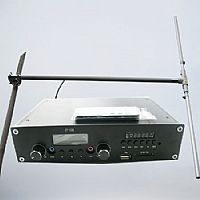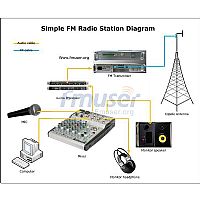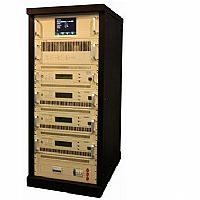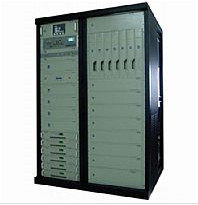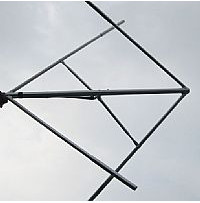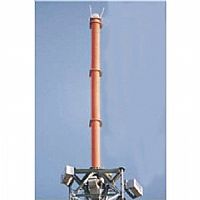This "simpler" approach calls for simply switching the audio channel between the Left and Right inputs. Each channel is sequentially connected for one half cycle of the 38 kHz carrier. That produces both the 38 kHz double sideband signal and the baseband signal. A low pass filter reduces the "splatter," resulting from harmonics of the switching, on adjacent radio channels. I understand that this is how one of the low cost single chip encoders works. It makes sense, this method relies on matching of components and no precision circuitry. Its nearly fool proof.
Switching in this way generates a 38 kHz double sideband signal and passes both L and R through the baseband. L and R have opposite polarities in the decoder because L is allowed through to the transmitter on one half of the 38 kHz cycle and R is allowed through on the other half. When L and R are equal, the two signals average out to zero over each cycle. It could not be simpler.
Photo 2. I just had to look. It really makes DSB.
Spectrum analyzer display of signal across C4 in schematic (figure 4).
Here, the Left channel was driven by a 1 kHz sine wave. Notice that the circuit
really produced 38 kHz double sideband with the carrier suppressed by 22 db. When
I jumpered the Left channel to the Right channel, the sidebands disappeared.
The circuit
Figure 3. The switch to ground is actually implemented
by two separate I/O pins on a micro controller.
The only tricky part is achieving the 2:1 analog multiplex function with a micro controller. This needs to be done without switching the DC level of the signal, because that would cause the 38 kHz carrier to feed through. CMOS Micro controller I/O ports can switch between high impedance and low impedance states. But when in the low impedance state, the pin can only be at either ground (logic low) or at the positive power supply (logic high). That means that the switching action must take place by mixing the Left and Right signals resistively, then basically shorting out one, then the other in alternation. To maintain the condition that the switch not changing the DC level of the signal, the signal will have to be centered around ground or the positive power supply. I chose ground since the input signal would be referenced to ground.
What the data sheets do not tell us is that the FET that drives the output pin low, an N-Channel FET, is pretty good a sinking current from signals above ground and sourcing current from signals below ground. Let me say that last part again:
The N-Channel FET that drives the output pin can shunt signals below ground to ground. It is very much like a low value resistor that can be turned on and off. When the I/O port is in a high impedance state, if the signal tries to swing too far below ground, either the ESD protection device on the I/O pin or the parasitic diode that is intrinsic to the FET will conduct, clipping the signal. In this circuit, noticeable clipping at the I/O pin starts at several hundred millivolts below ground.
Since the FM transmitter in this circuit only needs a few tens of millivolts to attain satisfactory modulation, there is no need for amplification of the output of the multiplexer. There is more about modulation sensitivity in the part of this section that deals with the transmitter circuit
(click here to jump to that discussion).
To perform the switching between high impedance and low impedance to ground, the firmware zeros to the corresponding port registers registers, then at appropriate times, it clears the corresponding data direction register bits to make a given pin a high impedance, and at the appropriate times, the firmware sets the corresponding data direction register bits to make the a given pin a low impedance to ground.
Looking at the schematic in figure 4, the micro controller derives its timing from a 6 MHz crystal. 6 MHz is not an exact integer multiple of 19 kHz. In fact, it is the 315.7894th harmonic of 19 kHz. But there is no need to worry - we're talking analog here. I just count down by 316 and call it close enough, because the difference is only 0.06%. I used 6 MHz because I have a bag of them on hand. If you wanted to, you could use a crystal that is an exact integer multiple of 19 kHz. By the way, even higher frequency clocks can get you smaller errors. A 20.000 MHz crystal gets you only 0.04% error - about the same tolerance as many microcontroller crystals -just remember to modify the firmware to accommodate the different clock rate.
One might ask if using a micro controller to simply replace an oscillator, counter, and some transmission gates is kind of a waste of a good processor. It frustrates me to let most of a very competent RISC processor spend most of its time in timing loops and doing trivial bit twiddling, but when looking at the alternatives, use of a micro controller reduces the parts count, it is easily obtainable, and in very many cases, a less expensive solution than most of the other solutions available.
The Left and Right signals are AC coupled through C1 and C2, respectively. The purpose of AC coupling is remove any DC component of the source signal to allow the signals at the U1's (the AVR) I/O pins to operate symmetrically around ground.
At every half cycle of the 38 kHz clock rate, either U1 pin 7 or U1 pin 5 is grounded, while the other pin is left floating, which allows one signal at a time to get through to the input of the transmitter.
A 19 kHz square wave pilot signal is provided from U1 pin 6. Since the average DC level at pin 6 is +2.5 volts, a small capacitor is placed in series to keep this DC component out of the modulator (consisting of U1 pins 7 and 5), so there won't be any 38 kHz carrier.
All three of the signals - Left, chopped by 38 kHz, Right, chopped by 38 kHz of opposite phase, and a low level pilot signal are resistively mixed at C4. I used the stereo indicator on my portable FM radio to find the value of R5, which in turn sets the amount of pilot signal in the composite signal, then I doubled the signal level. This should be more than enough, but feel free to decrease the value of R5. Cutting its value in half should not result in too much signal for the receiver.
The critical purpose of C4 is bypassing the base of the common base oscillator, Q1, to ground. The value was chosen so that the 38 kHz double sideband signal would not be rolled of significantly. I first calculated the maximum permissible value of C4 and then used the next smaller available size capacitor. After that, I tested it by trying a capacitor a little larger than the maximum calculated value and then then listening to a piece of music that features high frequency sounds moving from left to right. The larger capacitor significantly affected the separation of the higher frequency signals. The .01 uf capacitor shown in the schematic had not audible effect, and that's good because it wasn't supposed to.
The transmitter itself should look familiar to anybody who has ever home brewed an FM wireless microphone circuit or one of the FM transmitter circuits on this site:
An FM Broadcast Audio Transmitter
1.5V Battery Operated FM rebroadcast transmitter
An FM transmitter on this site that does not use this same oscillator, but is crystal controller, is on this web page:
http://www.cappels.org/dproj/LMX1601FMxmttr/LMX1601%20PLL%20FM%20Transmitter.html
If the links above don't work, it may be because you are looking at an unauthorized copy of this web page. It happens. All of these projects can be found at http://www.projects.cappels.org
This very simple circuit, the workhorse of the home brew wireless microphone projects, was pressed into service for the very reason that it is so popular with hobbyists: it doesn't require very many parts, it can be built with or without a printed circuit board, and usually actually works with enough tweaking.
In the transmitter, C3 decouples the base to ground through C4. C7 Can be a few pf above or below 5 pf without throwing things terribly out of whack. Try to keep the variable capacitor, C6, small. If you can only find larger capacitors, say 10 to 45 pf, put a 10 or 12 pf fixed capacitor in series with it. Its important to keep this part of the capacitance of the resonant tank as low as possible. If you don't have a suitable variable capacitor, you can always just put in a 5 pf fixed capacitor and rely on your ability to tune the circuit by stretching and distorting L1.
Q1 is a common 2N4401, and it exhibits a collector to base capacitance change of about 1.5 pf per volt. This is higher and better for this application than what you would get from high frequency transistors with lower output capacitance. The more of the tank capacitance that comes from Q1's collector-to-base capacitance, the more frequency modulation of the transmitted signal you will get for a given audio level. Since the stereo modulator can only handle several hundred millivolts peak-to-peak without distortion, this sensitivity is important.
I made L1 by winding 7 turns of #22 Beldsol copper magnet wire around the smooth part of a 1/4" drill bit (a trick mentioned by the legendary Harry Lythall), and then slipped the coil off the drill bit. I was shooting for the lower part of the FM band. Once the coil was wound and installed, I put C6 in the center of its range and then stretched and bend the coil until I could hear the transmitter on my FM radio tuned to the only quiet spot on the dial here, 93.3 MHz. If you want to use this at the high end of the FM broadcast band, you might want to try using only 6 turns.
Another trick for winding coils like this, that have to maintain their shape without a coil form, is to cut off a piece of wire a little longer than would be needed for the coil, then holding each end of the wire with a pair of pliers, stretch the wire slightly to orient the grain so that the wire tends to stay straight. When you wrap the wire around the drill bit, it will tend to hold its new shape instead of trying to spring back to its old shape. Be careful how you hold the wire while stretching it -you wouldn't want to hit yourself in the face with the pliers should the wire snap. Happened to me once; its not really funny.
The Antenna
This transmitter does not have a discreet antenna. L1 radiates plenty. An external antenna would extend the range, which is probably not what you really want anyway. It will also complicate tuning, which is something else you probably don't really want. I get nearly 10 meters to three of my portable FM receivers with this. It could be stronger, but 10 meters is more than enough. My neighbors don't really need to know what I am listening to.
The firmware
The firmware is quite possibly quite likely the simplest piece of functional code that I have ever written. It merely sets the 19 kHz signal pin high, waits a bit, then sets one of the 38 kHz pins to high Z while it sets the other 38 kHz pin to low Z. It delays a little more, then makes the high Z pin low, and the low Z pin high, waits some more... I think you get the idea. The modulator outputs switch between high and low impedance at 38 kHz, the 19 kHz output is a 19 kHz square wave. It was a bit tedious, to test in AVR Studio, but worth it.
The code is very simple. Just wait loops padded out with some no ops, separating changing of the state of the I/O pins. The tiny little program only a few very basic instructions, no long jumps, interrupts or special functions, relying only on the reset vector and these seven assembly language instructions:
cbi sbi
dec brne
nop rjmp
ldi
Most likely, the ATTINY12 code will run on any AVR controller that has an available PORTB, but I have not confirmed that this is the case - its only speculation. I have provided links at the bottom of this page to code for the ATTINY12, ATTINY15, the ATTINY2313 / AT90S2313, and the AT90S2323. I have tested all five of these chips in this circuit and found them to all work as expected. I guess that's one of the benefits of keeping things simple.
You should be able to use this technique on most other, if not all CMOS micro controllers with I/O pins that are capable of being placed in a high output state. If you realize success with a PIC or another small controller, please drop me a note at the email address at the bottom of this page.
Assembly
I built mine on a piece of punched phenolic board that had one pad per hole. The holes are in a 0.1" grid (2.54 mm). The pads help hold the components tightly to the board, but I am confident that one built on punched phenolic or fiberglass board, or even built Ugly Bug (A.K.A. Dead Bug) or Manhattan style would work just as well. Just make sure that the parts in the transmitter are mounted solidly to help with frequency stability and to reduce microphones.
I used a socket for the micro controller. This because I used a programing adapter that plugged into the socket for the purpose of programming the controllers, and also to let me change the controllers to verify that the other controllers would work. You don't need a socket, but it might give some peace of mind and some forgiveness of mistakes.
Testing and tuning -after assembly
If you use a socket for the controller, don't put the controller into the socket until you have verified that the power supply is wired properly. Apply unregulated power to the input of the 78L05 and measure pin 8 of the micro controller. It should be + 5 volts. Verify that pin 4 of the micro controller is grounded.
Tune a nearby FM radio receiver to a quiet spot on the dial, where you would like the transmitter to reside.
Tune C6 to the center of its range and touch L1 with your fingers. If you heard a signal go swishing though the band pass of your FM receiver, it means that the transmitter is tuned at a frequency higher than that which the FM receiver is tuned to. If you didn't hear the signal, then stretch the coil lengthwise SLIGHTLY.
At some point, between the effects of stretching the coil and touching it with your fingers, you should be able to bring the transmitter's frequency to be very close to that which the reviver is tuned to. At this point, you should be able to use C6 to fine tune the oscillator to the right frequency
After you get the transmitter tuned in, Verify that the transmitter is transmitting at the frequency that your radio is tuned to, and not to an image frequency. Do this by bringing your finger close to L1. When you do this, the frequency will shift. If the transmitter shifts to a lower frequency on your radio dial, then the transmitter is tuned to where you think it is. If the transmitter seems to shift up in frequency, then you are looking at an image and need to re-tune the transmitter.
The procedure above might be tricky, and often requires some finesse. Be patient, it will pay off.
It might be handy to have an un-tuned field strength meter at hand, just to be able to determine if the transmitter is oscillating at all. I relied upon one several times during this project. Here are a some filed strength indicator projects on this site:
Broadband RF Field Strength Probe using Atmel AT90S1200A AVR controller <= This one uses a micro controller to zero the circuit.
A Simple Field Strength Indicator <= This one does not require a micro controller.
Digital RF Field Strength Indicator with LED display using Atmel AT90S2313 AVR Processor <= This is the one I used on this project.
The "L" and "R" designations on the audio connector are, to my knowledge correct.
Thoughts on possible improvements
First off, one might consider adding ESD protection to the audio inputs.
Filters with sharp 10 to 15 kHz audio cutoff on the Left and Right audio channels might help with some audio sources. This would prevent signals that might be in the audio from beating with the 19 khz pilot signal.
Pre-empahsis, a 6 db per octave boost at about 3 kHz on the Left and Right audio channels will compensate for the de-empahsis rolloff in commercial receivers. North American receivers expect one frequency, the rest of the world, something slightly different. You might be able to achieve a similar effect with a graphic equalizer ahead of the transmitter. Using an equalizer in the receiver will restore the frequency response, but will not improve your high frequency signal to noise ratio as pre emphasis was intended.
Printed Circuit Board Design for 8 pin AVR controllers
In the photo above, Jeff attached a clip lead to the coil on his transmitter
in order to increase the range a little bit. Note that the inductor is a sufficient
antenna for most uses and the extra antenna is not recommended.
Jeff Heidbrier, in Texas, has come up with a pretty nice printed circuit board design for this simple FM Stereo Transmitter. Jeff's layout accomodates 8 pin AVR controllers. The layout is intended to accept resistors mounted vertically, as shown in the photograph, so you have some flexibility in that you can use any size from 1/8 up to about 1/2 watt sizes.
This layout only requires three jumpers in order to make a single-sided board.
As for the dots per inch, Jeff wrote "Opening the file up with Microsoft paint and printing out the image gives 7.5 mm from the center of pin 1 to the center of pin 4." Its a good idea to verify the dot pitch in your own system (As an example, I use a Macintosh, so the dots per inch would probably need to be adjusted.) When everything is scaled properly, the distance between centers on U1, the 8 pin dual inline package, should be 0.1 inches (2.54 mm),
First posted in April, 2007. Updated January,2008, February 2008, April, 2008.

